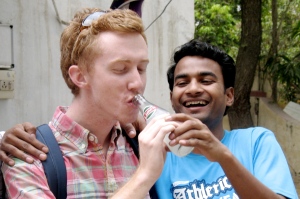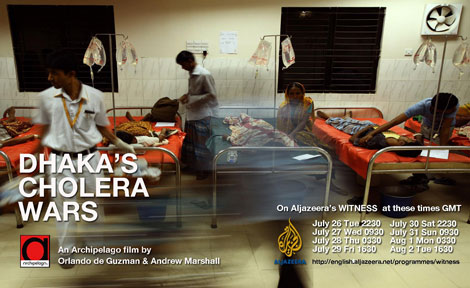By Jon Higgins, Medical Student
“Fogarty, meet Jon.
Jon, Fogarty.”
I was thrilled.
Months after submitting my application materials and attending a rather inspiring selection meeting, I received the phone call: I was offered a position as a 2011-2012 Fogarty International Clinical Research Scholar for the “Chronic Diseases and Public Health” project at the International Center for Diarrheal Diseases Research in Bangladesh (icddr,b).
It took a moment for that to set in. I would be returning to South Asia. To a place and a people who had provided such profound inspiration for my decision to enter medicine and pursue a global health career serving the underserved and marginalized. To a place and a people near and dear to my heart’s calling.
Being on my Surgery rotation when I got the news, I had little time for more than a subtle fist pump, a muttered exclamation, and it was back to the beloved OR. But my steps were much lighter that day.
The NIH’s Fogarty International Center supports the Fogarty International Clinical Research Scholars and Fellows (FICRS-F) program for graduate and professional students in the health sciences. The program funds and coordinates a mentored clinical research experience at select sites in low and middle-income countries (LMICs) on relevant and timely global health issues. Every scholar also has an international, in-country “twin” researcher at a similar level of training. The program fits perfectly into Duke’s Third Year research requirement, and many other Duke MS3’s have participated in years past. I am quite thankful to have received the grant as many, many competitive applicants – no less qualified than me – could not be funded.
This past July, all of the US and international scholars and fellows – as well as the international Doris Duke Clinical Research and Fulbright-Fogarty Fellows – met in Washington, DC for a 2-week orientation session at the National Institutes of Health in Bethesda, MD. We engaged in inspiring invocations from prominent global health researchers; heartfelt, weighty, honest late-night conversations with fellow scholars; and intensive training seminars in basic research methodologies, biostatistics, manuscript writing, the state of global health, and the cutting edge research happening around the globe.
We all left thoroughly energized, knowing that we had a community and organization that would understand and support us. A month to study for and take the USMLE Step 1, and I was off to Bangladesh.
“Bangladesh, meet Jon.
Jon, Bangladesh.”

Bangladesh sits nestled between India to the West and North, Myanmar to the Southeast, and the Bay of Bengal to the South. The capital, Dhaka, lies in the very heart of Bangladesh. Image source: CIA - The World Factbook, https://www.cia.gov/library/publications/the-world-factbook
Bangladesh is a country of 158 million people, packed into a land mass slightly smaller than Iowa. Originally named East Pakistan, the country seceded from West Pakistan in 1971 after a bloody war of independence, and became Bangladesh.
Nearly 90 percent of Bangladeshis are Muslim, another 9% Hindu, and 1% other religions. Most work in agriculture (rice), garment export, and the service industry; but 40% of the population remains underemployed, working less than full-time. GDP per capita is $1700 per year, making Bangladesh one of the poorest countries outside Sub-saharan Africa.
The mighty Brahmaputra and Ganges rivers from the Himalayas and plains of India merge before delivering their waters to the delta which composes the majority of the southern half of the country. One-third of the country floods annually, bringing its own set of difficulties. Combine this with poor sanitation infrastructure in many urban and rural areas, and water-borne diseases abound – including typhoid, bacterial and protozoal dysentery, and hepatitis A and E and the infamous cholera. Dengue fever and malaria are common in certain areas of the country as well.
However, as is the case in many developing countries, chronic diseases such as cardiovascular disease, diabetes, cancer, and chronic lung disease are increasing issues and, unfortunately, highly underdiagnosed. For example, recent studies imply that nearly 1/3 of the urban and 1/5 of the rural populations have some sort of glucose abnormality, meaning diabetes or pre-diabetes [1]. Efforts to reduce child and infant mortality in recent years have also been remarkably successful due to government and NGO programs, though reducing maternal mortality has proven more difficult [1].
Human trafficking is a major social justice issue in Bangladesh; the US State Department gave the country a Tier 2 Watch List rating in its 2011 Trafficking in Persons Report, stating it is “a source and transit country for men, women, and children trafficked for the purposes of forced labor and commercial sexual exploitation”. Fortunately, though, the Government of Bangladesh is making significant efforts to address labor and sexual trafficking.
The undeniable observation on makes upon arrival in Dhaka, the capital city, is that it is crowded. Over 14 million people live in the city proper, with over a third in slums, and it is the fastest growing megacity in the world, doubling its population every 12 years at current rates. The entire metropolitan area is estimated to have a staggering 21 million slumdwellers by 2015.
Though faced with many pressing social, political, and health concerns, Bangladesh is a place with wonderful cultural charm. The Bengal Renaissance of the 19th and 20th centuries paved the way not only for the birth of modern Bengali culture, but is considered by many the birthplace for much of the modern culture of the entire Indian subcontinent. Experienced travelers of Asia know that Bangladesh is one of the best kept secrets for natural beauty as well, from its mighty mangrove forests of the Sundarbans in the southwest to the tranquil northeastern tea plantations of Srimongal.
But those who know Bangladesh know that it is the overwhelming kindness, selfless hospitality, and warm hearts of the Bengali people that make their country so remarkable. I am honored to be their welcomed guest.
“ICDDR,B, meet Jon.
Jon, ICDDR,B.”
Originally named the International Centre for Diarrhoeal Diseases Research, Bangladesh, icddr,b has grown over the last 40 years to be a leader in many other arenas of global health research. The discovery of oral rehydration solution during cholera outbreaks in the 1960’s certainly catapulted icddr,b into the international spotlight. Since then, an estimated 40 million childrens’ lives have been saved from ORS alone, whose adversary – diarrheal disease and the resulting dehydration – still remains one of the top 3 killers of children today.
Yet icddr,b has recruited leading scientists in chronic disease, infectious disease, reproductive health, child health, implementation science and so much more. They have been awarded funding from multiple international governments and private foundations including the Bill and Melinda Gates Foundation, advised policymakers at the local, national, and international level, partnered with major local and international NGOs, and published papers in high-impact peer-reviewed medical journals including Lancet, Nature, PLoS One, and many others. They also maintain the Health and Demographics Surveillance System in Matlab, Bangladesh, an ongoing surveillance of an impressive 40 years of comprehensive longitudinal health and demographic data on a rural population of over 200,000. At Matlab, the importance of vaccinating pregnant mothers against tetanus to prevent neonatal death was demonstrated – a practice now adopted worldwide.
The hospitals of icddr,b treat up to 150,000 patients each year, at the cost of about $5 per patient per day.
Let that soak in.
It is a staggering number, given the remarkable outcomes which they achieve, sometimes even surpassing their high-income country counterparts. During the biannual diarrhea epidemics in Dhaka (April-May and August-September), icddr,b can treat over 500 new patients per day . If you have 20 minutes, watch a special from Al Jazeera’s award-winning documentary filmmaker, Witness, about icddr,b’s Dhaka hospital: “Dhaka’s Cholera Wars”
Yet perhaps the most impressive thing to me, after arriving here only a short time ago, is the incredible rootedness which icddr,b researchers and clinicians maintain in the local and national community. A large number of the research programs address relevant, timely issues and needs in both the urban and rural poor and marginalized communities of Bangladesh. Their hospitals provide care at no cost, and they do not fear to take on the controversial issues unashamedly (domestic abuse, abortion, HIV/AIDS). The vast majority of the 3,000 staff are Bangladeshi, many with education that would allow them to “escape” the difficulties of their country – but have chosen instead to stay and address them. “Ivory tower” mentality is certainly not the norm at icddr,b. This is perhaps what makes its impact so effective, and what made it so attractive as a place for me to join for a year in clinical research. I am honored and privileged to join them in their work, though for only a short time
To read more about the current activities of icddr,b (if you have kept interest thus far!), download their 2010 Annual Report here.
My role in all of this.
For the next few weeks, I will continue to meet with the heads of different centers at icddr,b to discover feasible yet achievable clinical research project(s). My specific interests include health systems access research, implementation science, the role and effectiveness of community health workers in the healthcare system, and more, particularly regarding surgical disease and MNCH (maternal, neonatal, and child health). I will also have the chance to observe clinical rounds in the ICU, HIV ward, and other teams and travel around the country on field site visits, whether to the slums of Dhaka, our field hospital in Matlab, or one of many other rural sites where icddr,b works.
I look forward with great anticipation to how I may become involved here, and what I will learn along the way. I hope you’ll enjoy reading about my experiences, and I certain welcome your feedback and comments. I will also be blogging this content and more at http://jrhbangladesh.wordpress.com. Feel free to join me there, too.
That is all for now, though I do realize it was quite a bit. Future posts will (hopefully) be far more pithy, artistic, insightful and interesting, so stick with me.
But for now, it’s time to meet some colleagues for afternoon tea.
Jon
 Sources cited: 1. ICDDR,B Annual Report 2010. Accessed 5 September 2011. http://www.icddrb.org/what-we-do/publications | 2. CIA – The World Factbook, Bangladesh https://www.cia.gov/library/publications/the-world-factbook/geos/bg.html
Sources cited: 1. ICDDR,B Annual Report 2010. Accessed 5 September 2011. http://www.icddrb.org/what-we-do/publications | 2. CIA – The World Factbook, Bangladesh https://www.cia.gov/library/publications/the-world-factbook/geos/bg.html
The views, opinions, photographs, videos, and other content expressed on this blog are my own, unless stated otherwise. The do not necessarily represent those of the NIH, Fogarty International Center, ICDDR,B, Duke University, or any other organization with which I affiliate. Written consent is obtained for photographs which are identifiable; where this is not feasible, I obtain verbal consent. Consent is also obtained before posting any specific health-related information, and still every effort is made to de-identify the information.


Leave a comment